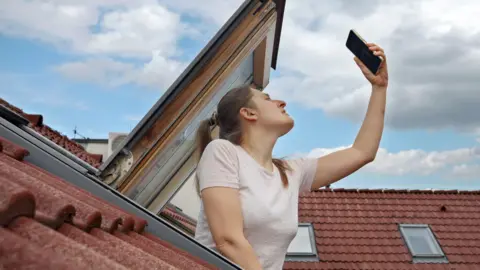Is my mobile lying to me? When 5G doesn’t mean 5G

 Getty Images
Getty ImagesWhen you see the 5G symbol at the top of your phone, you probably assume you’re getting faster internet speeds – the kind promised when it first arrived five years ago.
Mobile networks told us that 5G would provide us with faster downloads, smoother streaming and instant connectivity.
It has received lots of investment from mobile operators and the government but has faced several setbacks, particularly as 5G requires a lot of masts because it delivers faster speeds over shorter distances.
New research suggests that the 5G symbol you see on your screen might not match what you’re actually getting in terms of internet speed.
Tests carried out by research group Policy Tracker, and shared with BBC’s Morning Live, found that nearly 40% of the time a phone displays the 5G symbol, it is actually using a 4G connection.
That means you could be paying for, and seeing, 5G while your phone quietly sticks to slower speeds.
The peak theoretical download speed for 5G is up to 20,000 megabits per second which is fast enough to download 18 HD films in under a minute, but for many of us our speed is far lower than that.
The research comes as some mobile networks begin rolling out “standalone 5G” – a new service that, they say, promises true 5G speeds all the time.
In order to benefit from this you will need to purchase a specific phone plan which often comes with a higher price tag.
What should I do if I’m not getting 5G?
If you have a contract that includes 5G, but you don’t think you’re getting a regular and reliable 5G signal you should:
- Check your speed: Use an online speed test to see your real download and upload rates
- Check your coverage: Ofcom’s mobile coverage checker shows which network offers the best 4G or 5G signal in your area. Once you enter a postcode, you’ll see whether a 4G/5G signal is available locally and whether the signal is good or variable. It can also show you which provider has the best coverage for the area.
- Contact your provider: If you’re not happy with the coverage and signal strength of your current provider it’s worth contacting them to explain the problem and see what advice they can provide you with.
- Change provider: If you’re not locked into a contract it can be simple to swap to another provider that offers better coverage.
‘Not worth it’
Policy Tracker conducted 11,000 tests across central London, the outskirts of Birmingham and a village in North Lincolnshire, using four different phones connected to four different network providers.
It found that while phones often display the 5G logo, the data being transmitted is still carried by older 4G infrastructure.
The difference isn’t always obvious to users, but it can mean slower downloads and buffering in places where they expect the ultra-fast network.
The issue comes down to how mobile networks currently define 5G.
Martin Simms from Policy tracker explains that the symbol on your phone shows the “presence” of a 5G signal in the area, but doesn’t guarantee that your phone is connected to it.
He says that even with the “standalone 5G” service, your phone can still drop down to 4G if a faster connection is not available.
He says that for most people, “standalone 5G isn’t worth it as it’s not very good value for money because the contracts are expensive”.
He adds that the coverage is still patchy, even in big cities like London although he does say this new service means “you’re more likely to get better service in busy areas like train stations”.
Consumer expert, Jasper Griegson from the complaints service Resolver told the BBC that customers are entitled to clarity.
You think you’re getting one thing but you’re not and accuracy is key,” he said. “The consumer rights act has very strict rules about how accurate things have to be in other contexts, so why does that differ here?”
In response, Mobile UK, the trade body representing Britain’s major mobile operators, confirmed that the 5G icon doesn’t necessarily mean a live 5G connection.
It said the symbol indicates a user is in a 5G-enabled area, and that networks “dynamically and seamlessly steer customers to the best connection, whether 4G or 5G, based on real-time factors like signal strength”.


